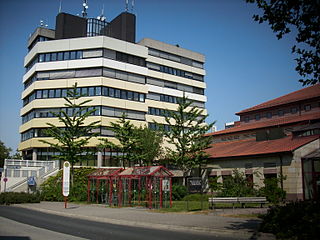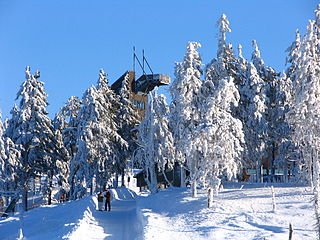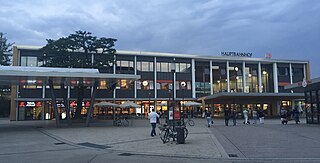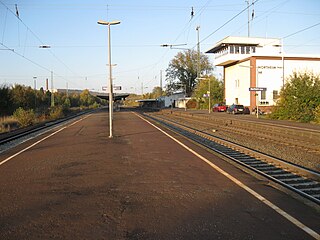
Northeim is a district in Lower Saxony, Germany. It is bounded by the districts of Holzminden, Hildesheim, Goslar and Göttingen, and the state of Hesse.

Goslar is a district in Lower Saxony, Germany. It is bounded by the districts of Göttingen, Northeim, Hildesheim and Wolfenbüttel, the city of Salzgitter, and by the states of Saxony-Anhalt and Thuringia (Nordhausen).

Hannover Hauptbahnhof is the main railway station for the city of Hanover in Lower Saxony, Germany. The railway junction is one of the 21 stations listed as a railway Category 1 station by DB Station&Service. It is also the most important public transport hub of the region of Hanover and it is served regional and S-Bahn services. The station has six platforms with twelve platform tracks, and two through tracks without platforms. Every day it is used by 250,000 passengers and 622 trains stop at the platforms. About 2,000 people work here.
The South Harz Railway is a railway line through the German states of Lower Saxony and Thuringia. It runs from Northeim to Nordhausen, via Herzberg am Harz, Bad Lauterberg-Barbis, Bad Sachsa, Walkenried and Ellrich. The line is 69 kilometres (43 mi) long.
The Royal Hanoverian State Railways existed from 1843 until the annexation of the Kingdom of Hanover by the Kingdom of Prussia in 1866. At that time its railway network, which comprised 800 kilometres of track, went over to the Prussian state.

The Leine Uplands is a region in Germany's Central Uplands which forms a part of the Lower Saxon Hills and lies along the River Leine between Göttingen and Hanover. It borders on the Weser Uplands in the west, the Innerste Uplands in the northeast, the Harz in the east and Untereichsfeld in the southeast.

The Leine-Heide Cycle Path is a long-distance cycle path in Germany that has a total length of 410 kilometres (250 mi) and runs through the German federal states of Thuringia, Lower Saxony and Hamburg. Until 2009, it was called the Leine Cycle Path, after the River Leine; it ended north of the river's confluence with the Aller in Hodenhagen. Heide (‘heath’) refers to the Lüneburg Heath.
The Lehrte–Nordstemmen railway is a continuous double track, electrified main line railway in the German state of Lower Saxony. It connects the railway junction of Lehrte with Hildesheim and Nordstemmen, where it connects with the Hanoverian Southern Railway. The section from Lehrte to Hildesheim opened in 1842 and is one of the oldest lines in Germany.

Hildesheim Hauptbahnhof is the main railway station for the city of Hildesheim in Lower Saxony, Germany. The station opened in 1961 and is located on the Lehrte–Nordstemmen, Hildesheim–Brunswick and Hildesheim–Goslar railway. The train services are operated by DB Fernverkehr, Erixx, Metronom and NordWestBahn.

The Hildesheim–Brunswick line is a 43 km long electrified main line railway in the German state of Lower Saxony. It forms part of the Intercity-Express route from Frankfurt to Berlin. It is also used as a diversion route from the Hanover–Brunswick line. It is a single track line from Hildesheim to Groß Gleidingen. A proposal to duplicate the line was included in the Federal Transport Infrastructure Plan of 1992.

Lehrte is a railway station located in Lehrte, Germany. The station opened on 15 August 1843 and is located on the Berlin-Lehrte Railway and Hanover–Brunswick railway. The train services are operated by Deutsche Bahn, WestfalenBahn and Metronom.

Sarstedt is a railway station located in Sarstedt, Germany. The station is located on the Hanoverian Southern Railway. The train services are operated by Deutsche Bahn, Metronom and Erixx. The station is also served by the Hanover S-Bahn.
The Göttingen–Bodenfelde railway, also called the Oberweserbahn and in Göttingen the Bodenfelder Bahn, is a standard gauge railway in South Lower Saxony. The single-track, non-electrified branch line runs from Göttingen to Bodenfelde through the Weser Uplands. It is used mainly by local traffic, but it is also used by through traffic. The route was once used, for example, by Düsseldorf–Göttingen traffic.

The Hildesheim–Goslar railway is a 53 kilometre long, double-track and non-electrified main line in the northern Harz foothills in the German state of Lower Saxony. It serves mainly to connect with the tourist region in the northern Harz with Hildesheim and Hanover. It is served by the HarzExpress, running between Halle, Halberstadt, Goslar and Hannover Hauptbahnhof. The most important station and junction of the line is Salzgitter-Ringelheim station.

Salzgitter-Ringelsheim station is a station in the town of Salzgitter in the German state of Lower Saxony. It is located in the extreme southwest of the urban area in the district of Salzgitter-Ringelheim. Salzgitter has no central station and Salzgitter-Ringelsheim station, despite its remote location, is the main station in Salzgitter.
The Vienenburg–Langelsheim railway was a nearly 18-kilometer-long railway along the northern edge of the Harz in the German state of Lower Saxony. It was mainly used for freight traffic. It was opened in 1875, but it lost its importance with the closure of a line connecting to the east as a result of the division of Germany after the Second World War and it is now closed and dismantled.

Nordstemmen station is located on the Hanover–Göttingen railway and the Hildesheim–Löhne railway in the town of Nordstemmen in the German state of Lower Saxony. The station building was built by Conrad Wilhelm Hase (1853–1854), but it has not been used by Deutsche Bundesbahn or Deutsche Bahn since 1977. Since 2011, the Hildesheim contractor Dirk Bettels has tried in vain to acquire and rehabilitate the grade II heritage-listed station building with public funds. Construction work begun by Dirk Bettels was discontinued at the end of March 2013 because no contract had been signed by Deutsche Bahn.

Bad Harzburg railway station serves the spa town of Bad Harzburg in Lower Saxony, Germany. It is the southern terminus of the Brunswick–Bad Harzburg railway, one of the oldest lines in Germany, and the eastern terminus of a branch line to nearby Oker station. Regional rail services are operated by Deutsche Bahn AG and Erixx GmbH.

Northeim (Han) railway station is a railway hub in the town of Northeim, Germany. It is classed as category 3 station and has six platforms. In addition to 3 daily Intercity trains, regional railway trains stop at the station.

Kreiensen station is a Keilbahnhof in Kreiensen in the German state of Lower Saxony and along with Einbeck-Salzderhelden station one of two stations in the town of Einbeck.



















